Hawaii’s colorful flora offers a wide variety of botanical delights, such as a striking range of pink-colored flowers. The Hawaiian islands are home to an incredible array of pink flowers, both native and imported, that enhance the rich landscapes with a splash of color and beauty.
Let’s dive into the enchanting world of the 27 types of pink Hawaiian flowers, discovering their unique characteristics and how to identify these floral gems that thrive in the tropical paradise of Hawaii.
Different Types of Pink Hawaiian Flowers
Pinkfringe
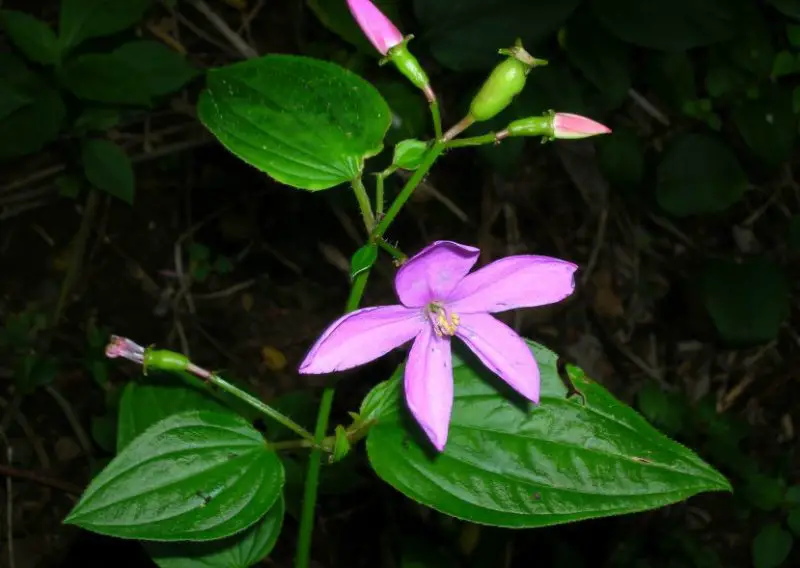
Arthrostemma ciliatum, commonly known as Pinkfringe, is a perennial herb/forb introduced to Hawaii. Originating from the tropical Americas, this naturalized ornamental garden plant displays captivating features.
With a height ranging from 3 to 13 feet, Pinkfringe boasts pink flowers measuring up to 2 1/2 inches across. The red flower buds precede four egg-shaped, point-tipped petals, potentially banded with red on the reverse side. Following each bloom is a red, elongated, cup-shaped fruit called a hypanthium. The leaves, slightly bristly with 5 or 7 longitudinal veins, are egg-shaped to broadly lanceolate, adorned with tiny reddish, bristly-hairy teeth along the edges.
These weedy, climbing, and sprawling plants can be found covering and smothering other vegetation in pastures, along forest edges, and roadsides in wet to mesic areas of Hawaii.
Bamboo Orchid
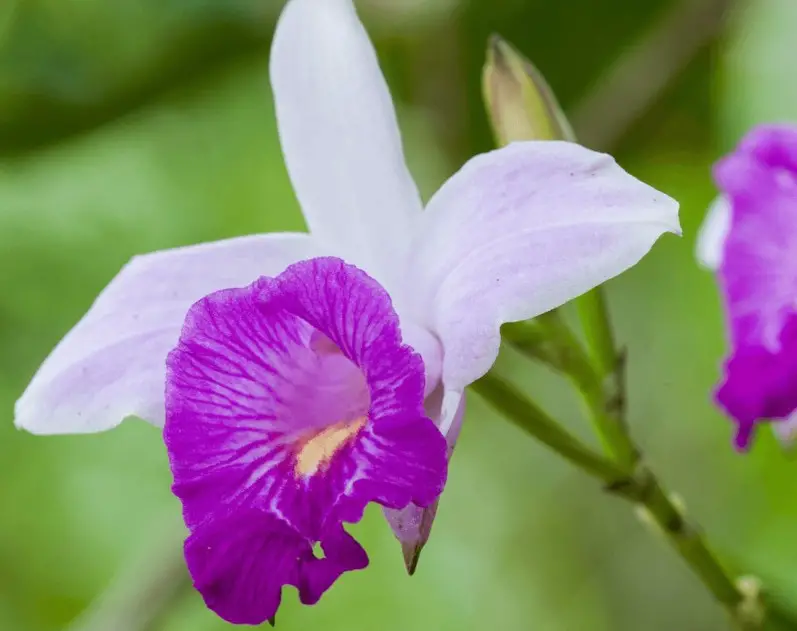
Arundina graminifolia, commonly known as Bamboo Orchid, is a perennial herb/forb introduced to Hawaii from tropical Asia, where it has naturalized as an ornamental garden plant.
With a height reaching up to 5 feet, the flowers of Bamboo Orchid showcase oval-shaped, white or violet-pink tepals and a ruffled magenta-edged labellum with a yellow center. As the flowers mature, they take on a pink hue. After blooming, the plant produces drooping seed capsules that split open into basket or birdcage-like structures, releasing minute, dustlike seeds into the air.
In non-blooming phases, Bamboo Orchid resembles young bamboo plants, with green, grasslike leaves and linear-lanceolate blades. Thriving in sunny, open, disturbed areas within wet to mesic forests, it also colonizes lava flows in Hawaii.
Bougainvillea
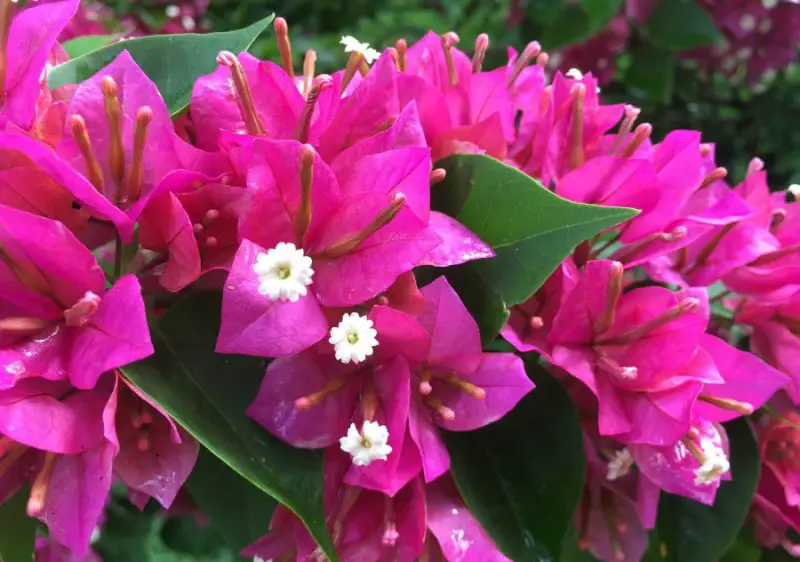
Bougainvillea spp., commonly known as Bougainvillea, is a perennial, evergreen plant cultivated in Hawaii. Originating from Brazil, these ornamental garden plants come in various varieties.
Featuring small, tubular, whitish flowers surrounded by papery, triangular to egg-shaped bracts in vibrant colors like pink, red, orange, yellow, purple, or white, Bougainvillea adds a burst of color to landscapes. The leaves, green or variegated, are alternately arranged and come in different shapes.
While some varieties can grow up to 40 feet tall, many cultivated types are more compact. With woody, brittle branches adorned with slender spines, Bougainvillea can climb or straggle. In Hawaii, various cultivated species and hybrids, such as Bougainvillea × buttiana, flourish. Notable species include Paperflower (Bougainvillea glabra) with pentagonal floral tubes and shorter, acute floral bracts, and Great Bougainvillea (Bougainvillea spectabilis) with rounded floral tubes and longer, obtuse floral bracts.
Lilac Tasselflower
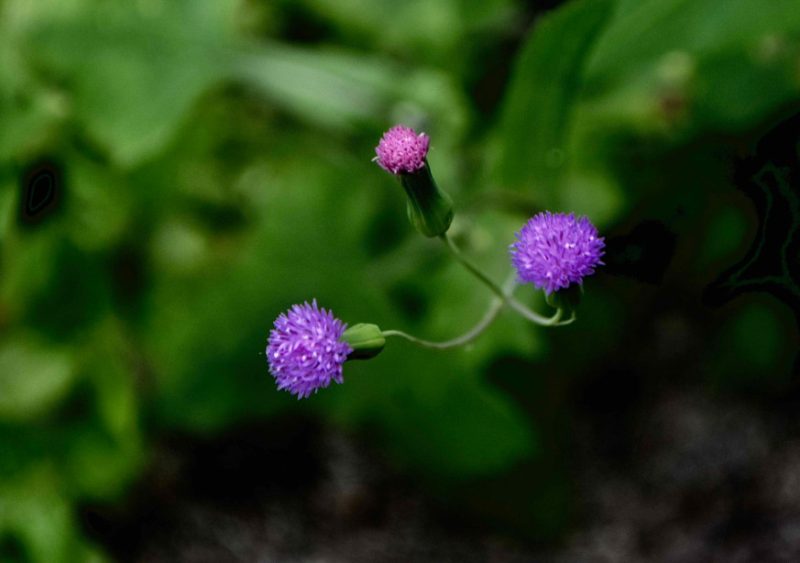
Emilia sonchifolia, commonly known as Lilac Tasselflower, is an introduced annual herb/forb in Hawaii, naturalized as a weed and food plant. Native to south Asia and the western Pacific, this plant showcases small, urn-shaped to bell-shaped flower heads in lavender pink or lilac, lacking rays.
The blooms are succeeded by seed heads releasing fluffy, wind-borne white seeds. Its green leaves, alternately arranged on weak, erect, and sparsely hairy stems, vary from broadly triangular to egg-shaped. Lilac Tasselflower thrives in sunny, open, grassy, disturbed areas at lower elevations in Hawaii.
Parakeet Heliconia
![]()
Heliconia psittacorum, commonly known as Parakeet Heliconia, is a perennial herb/forb introduced and cultivated in Hawaii. Native to South America and Trinidad, this naturalizing ornamental garden plant is celebrated for its vibrant features.
Displaying a spectrum of colors such as orange, red, yellow, pink, green, and cream, the flowers cluster above lanceolate floral bracts with a waxy bloom. The 3-angled, narrowly banana-shaped flowers have fused tepals and a dark-ringed tip. Followed by fleshy, dark blue fruits, the plant reaches heights of up to 5 feet. Its simple, long-petioled leaves are light green and lanceolate.
As the most commonly cultivated Heliconia species in Hawaii, Parakeet Heliconia escapes from gardens, naturalizing along roadsides and providing long-lasting cut flowers for tropical flower arrangements.
Pearlflower
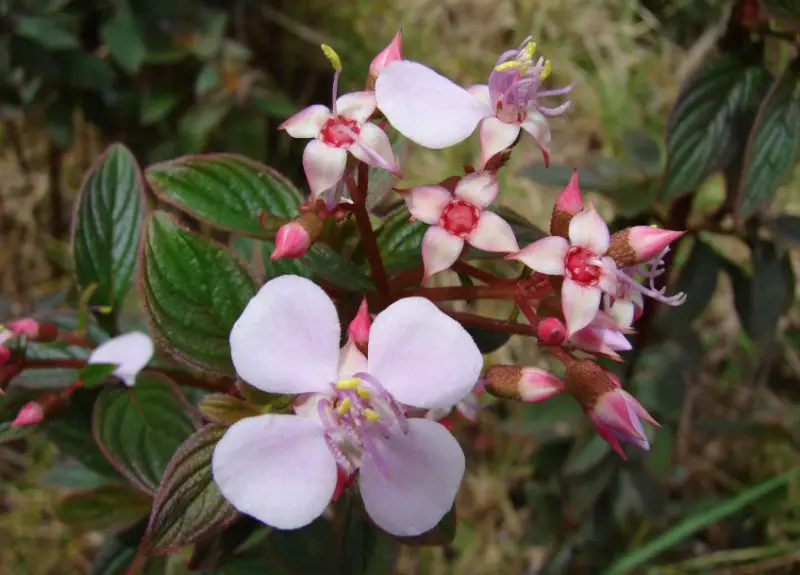
Heterocentron subtriplinervium, commonly known as Pearlflower, is a perennial shrub or subshrub introduced and naturalized in Hawaii. Originating from southern Mexico and Guatemala, this ornamental garden plant reaches a height of up to 6 feet.
The flowers, clustered at branch tips, boast 1/2 inch-wide, rounded petals in white or pink to magenta, accompanied by similarly colored, point-tipped sepals and distinct, appendaged anthers. Dark green, shiny leaves with depressed veins and reddish margins complement the plant’s appearance. Thriving in moist, partly shady locations in disturbed areas and at forest edges, Pearlflower is a weedy species in Hawaii.
Littlebell
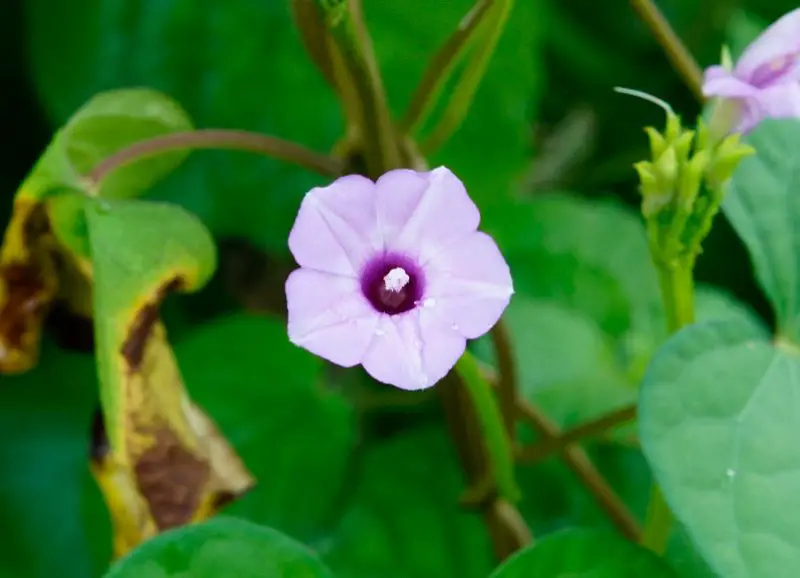
Ipomoea triloba, commonly known as Littlebell, is an introduced annual vine or herb/forb found in Hawaii. Native to the tropical Americas, it has naturalized globally in tropical regions.
The small, pentagonal flowers come in shades of pinkish-purple, pink, or white, with a dark magenta-purple throat. Flowers may appear singly or in clusters, followed by rounded, bristle-haired seed capsules. The leaves, often heart-shaped, are green, hairless or sparsely hairy, and either entire, coarsely toothed, or deeply 3-lobed.
Littlebell typically reaches a height of less than 10 feet and is commonly found in lower elevations of dry to moderately moist grasslands and disturbed areas like old pastures, fields, and roadsides in Hawaii.
Squirrel’s Tail
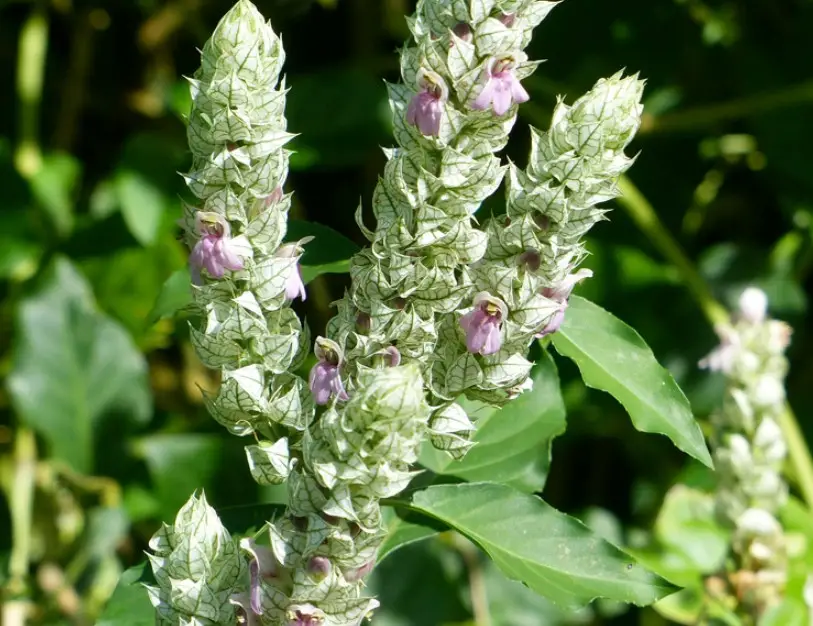
Justicia betonica, commonly known as Squirrel’s Tail, is a perennial herb/forb introduced to Hawaii from Africa and tropical Asia. This naturalized ornamental garden plant stands at a height of up to 5 feet or more.
Featuring small, pale lavender or pink, tubular flowers surrounded by three white bracts, Squirrel’s Tail presents an attractive appearance in upright, terminal or axillary spikes. The flowers, distinctly 2-lipped with a cupped upper lip and a 3-lobed lower lip marked with white and magenta-purple at the base, are followed by club-shaped seed capsules. The leaves are green, opposite, petiolate, egg-shaped to elliptic, and sparsely hairy at the margins and veins. The stems, tinged or lined with purple, are upright. This fast-growing and weedy plant thrive in disturbed mesic areas, spreading rapidly by seed to form dense stands.
Lantana

Lantana camara, commonly referred to as Lantana, is a perennial, evergreen plant introduced to Hawaii from Central and South America. Growing up to 6 feet tall or more, Lantana displays umbellate flower heads with multicolored blooms, transitioning from orange or yellow to pink when pollinated.
The tubular, nectar-filled flowers have four lobes, and the plant produces small, blue-black drupes cherished by birds. The leaves are simple, opposite, oval to oblong, and covered in rough, scratchy hairs, with toothed or scalloped margins.
In Hawaii, Lantana poses an invasive threat, particularly in pastures where its toxicity to livestock makes it a significant problem. Birds contribute to its spread by consuming the ripe berries and dispersing the seeds.
Rose Grape
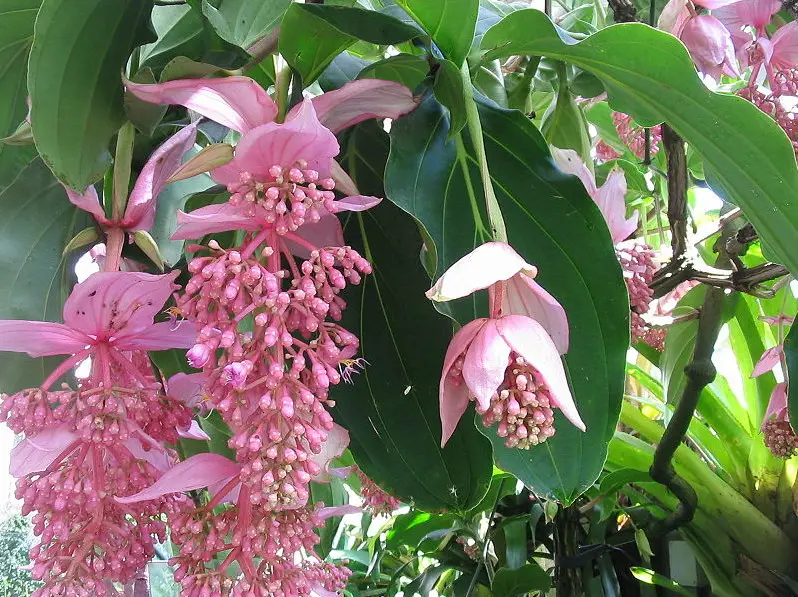
Medinilla magnifica, commonly known as Rose Grape, is a perennial, evergreen shrub introduced to Hawaii from the Philippines. Reaching heights of up to 8 feet, this naturalized ornamental garden plant displays numerous small flowers in large, pink, pendent panicles measuring up to 18 inches long.
The distinctive, whorled, pale pink bracts add to its charm. Following the bloom, grape-like clusters of small, pink ripening to purple berries appear. The leaves, up to 1 foot long, are glossy dark green, leathery, and oblong to egg-shaped.
While primarily cultivated in Hawaii, Rose Grape is gradually becoming naturalized in humid, wet to mesic windward areas on Oahu and the Big Island.
Melochia
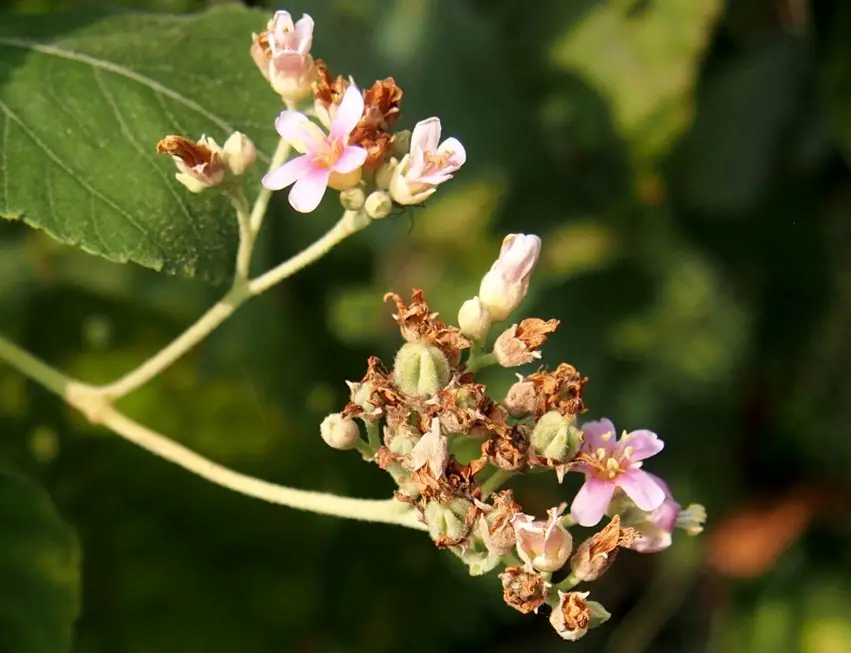
Melochia umbellata, commonly known as Melochia or Hierba del Soldado, is a perennial tree or shrub introduced to Hawaii from tropical Asia and Australasia. Exhibiting a fast-growing and weedy nature, it serves as a shade and reforestation tree, reaching heights of up to 50 feet but typically less.
The flowers appear in multiple, branched, flat-topped clusters at the branch tips, with colors ranging from pink and pinkish red to rare hues of orange, yellow, or violet. Following the blooms, grooved seed capsules contain winged, brown seeds dispersed by the wind. The leaves, with toothed margins, start as light gray and mature to light green. Stellate-hairy and heart-shaped, they contribute to the distinctive appearance of these shrubby trees. In forested areas, Melochia stands out due to its paler, silvery green foliage.
Commonly found in pastures and second-growth forests, Melochia is particularly prevalent near Hilo, Hawaii, where it was planted after a significant fire in 1928.
‘Ohi’a Lehua

Metrosideros polymorpha, commonly known as ‘Ohi’a Lehua or Ohia, is a native, perennial, evergreen tree or shrub endemic to Hawaii. Exhibiting varying heights, it can be a low-growing shrub or a towering tree, reaching up to 100 feet tall. ‘Ohi’a Lehua produces clustered, brush-like stamen flowers above the foliage, with colors ranging from red and orange to yellow, salmon pink, and occasionally white.
Flowering season peaks during spring, attracting endemic Hawaiian honeycreepers with its nectar-filled blooms. The woody capsules contain numerous tiny seeds. With dark green, oval to egg-shaped leaves, silver-gray shredding bark with age, and, in some areas, broom-like aerial roots, ‘Ohi’a Lehua is the most abundant and widespread tree in the main Hawaiian Islands. It plays a crucial role in ecosystem colonization, thriving from sea level to around 8500 feet in elevation.
Sensitive Plant
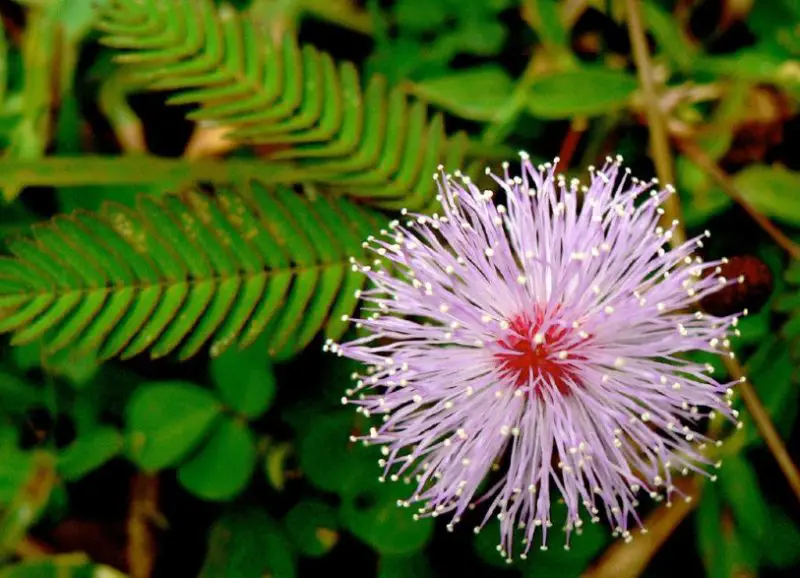
Mimosa pudica var. unijuga, commonly known as Sensitive Plant or Shameplant, is an introduced herbaceous perennial with annual tendencies. Native to tropical America, it has become a naturalized ornamental plant and a widespread pan-tropical weed.
Featuring spherical to egg-shaped flower heads with numerous tiny reddish-pink flowers, the plant stands up to 39 inches tall. Following the blooms, clusters of small, flat, pearl necklace-shaped bean pods develop, exhibiting prickly margins that aid in adherence to socks and animal fur. The bipinnately compound leaves are characterized by immediate drooping and folding upon touch or disturbance, showcasing a unique sensitivity.
Additionally, the leaves close at night, demonstrating nyctinastic behavior. The stems are reddish-brown, prickly, and can be either upright or trailing, particularly in mature plants. In Hawaii, Sensitive Plant is a prevalent weed in lawns and pastures.
Flowering Banana
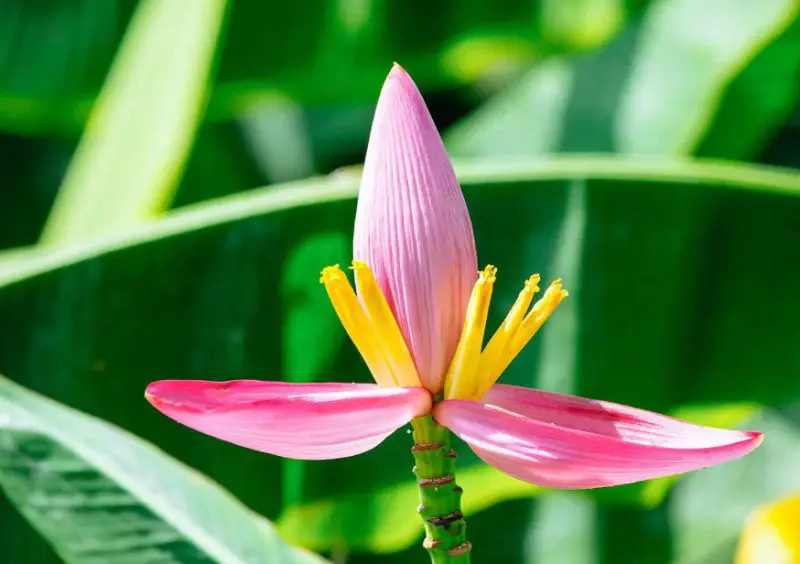
Musa ornata, commonly known as Flowering Banana or Ornamental Banana, is a perennial herb cultivated for ornamental purposes. Indigenous to India, Bangladesh, and Myanmar (Burma), this plant can grow up to 9 feet tall.
Its striking inflorescences emerge from the tip of the plant, displaying erect, elongated structures with pink to lilac, petal-like bracts that open to reveal rows of 3 to 6 deep yellow-orange flowers. Female flowers open first, developing into small bananas containing black seeds and creamy white flesh.
The banana-like leaves, up to 6 feet long, have a sturdy midrib, and the trunk-like pseudostems emerge from underground rhizomes, forming dense clumps. After flowering, the pseudostems die, completing the plant’s life cycle.
Pink Wood Sorrel

Oxalis debilis var. corymbosa, commonly known as Pink Wood Sorrel, is an introduced perennial herb with ornamental value, originating from South America. Growing up to 1 foot tall, this naturalized plant displays charming pink or pinkish lilac flowers arranged in umbel-like clusters above the leaves.
The individual flowers boast 5 round-tipped petals with a streaked base, and sometimes, cylindrical seed capsules follow the blooms. The stemless plants, with leaves forming a basal rosette, sprout from scaly, underground bulbs.
Particularly grown for its showier flowers, Pink Wood Sorrel thrives in moist, shady areas at lower elevations in Hawaii, reproducing through bulbils produced by the main bulb.
Frangipani
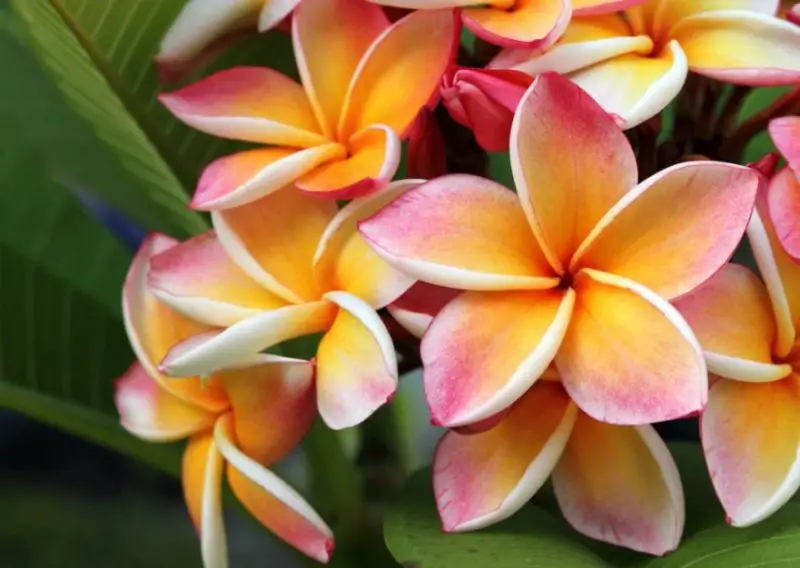
Plumeria rubra, commonly known as Frangipani, is a perennial, deciduous tree or shrub cultivated in Hawaii for its ornamental beauty and use in leis. Native to Mexico, Central America, Colombia, and Venezuela, it reaches a height of up to 25 feet.
The flowers, emerging before the leaves in spring, form clusters at the branch tips, with tubular blossoms showcasing 5 oval lobes in various colors, including red, pink, orange, yellow, and white. Following the blooms, dry, brown, seed follicles appear. The matte green leaves are leathery, narrowly elliptic, and clustered at the tips of thick, fleshy, brown branches, creating an open, branching form.
A beloved choice for tropical gardens in Hawaii, Frangipani is commonly propagated through stem cuttings.
Pinkhead Smartweed
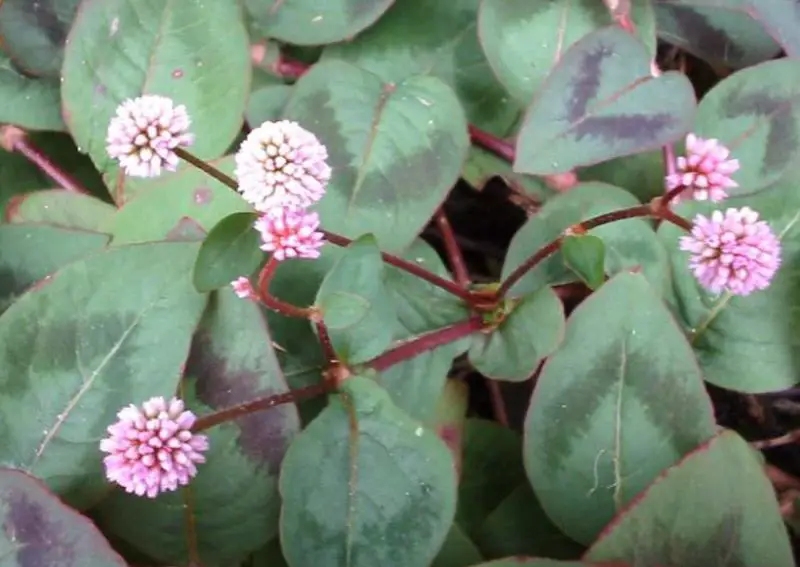
Polygonum capitatum, commonly known as Pinkhead Smartweed, is a perennial subshrub and herb/forb introduced to Hawaii. This naturalized ornamental groundcover hails from western China and the Himalayas.
Displaying tiny flowers in medium pink to whitish-pink hues, it forms ball-shaped or head-shaped clusters above the foliage. The leaves are alternately arranged, varying from green to reddish-purple, adorned with dark red edges and a distinctive V-shaped dark band, presenting an ovate to elliptic shape. Under stress, the leaves can turn bright red.
These mat-forming plants feature prostrate stems capable of rooting at the nodes and are commonly found along roadsides and in open lava fields at middle elevations on the Big Island of Hawaii.
Octopus Tree
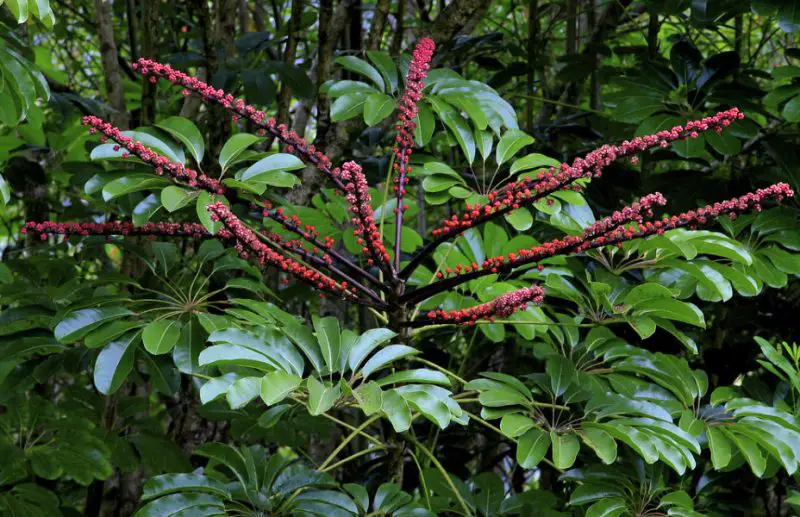
Schefflera actinophylla, commonly referred to as the Octopus Tree, is a perennial, evergreen tree introduced to Hawaii. Originating from Australia and New Guinea, it has naturalized as an ornamental garden plant and houseplant.
The plant exhibits stunning flower clusters, reaching up to 3 feet in width, resembling an octopus with splayed tentacles. Flower colors transition from greenish-pink to red during the summer, followed by purplish-black, blackberry-like fruits. Growing up to 40 feet tall, this fast-growing tree has weak, damage-prone branches that limit its height.
With alternate, palmately compound leaves, the Octopus Tree is prevalent in lower elevation areas with moderate rainfall in Hawaii.
Philippine Ground Orchid
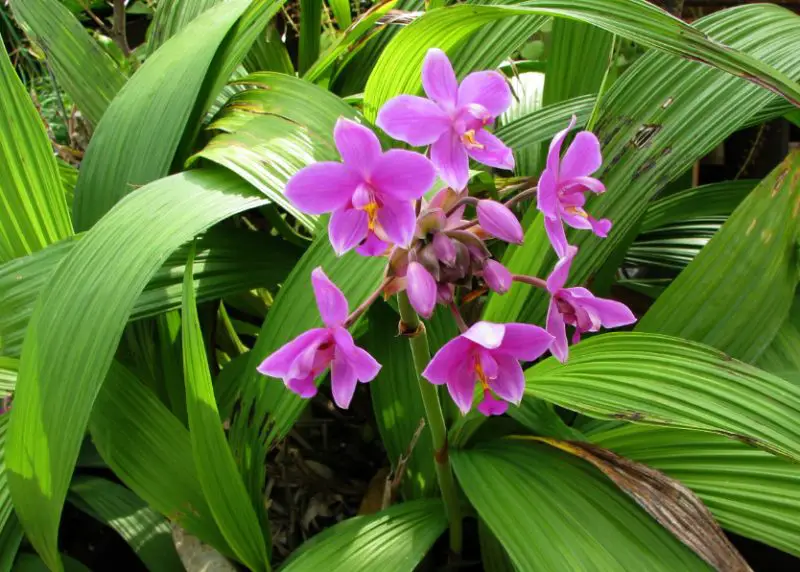
Spathoglottis plicata, commonly known as the Philippine Ground Orchid, is an introduced perennial herbaceous plant in Hawaii. Native to Southeast Asia, this naturalized ornamental garden orchid stands up to 40 inches tall.
Its striking flowers showcase five oval-shaped tepals in violet-pink, magenta-purple, or occasionally white. The spade-shaped labellum complements the vibrant colors of the blooms. Following flowering, the plant produces 6-ribbed seed capsules that split open, releasing minute, dustlike seeds into the air.
The bright green, linear-lanceolate leaves emerge from pseudobulbs and feature distinctive fanlike folds along their length, contributing to the orchid’s unique appearance.
Milo
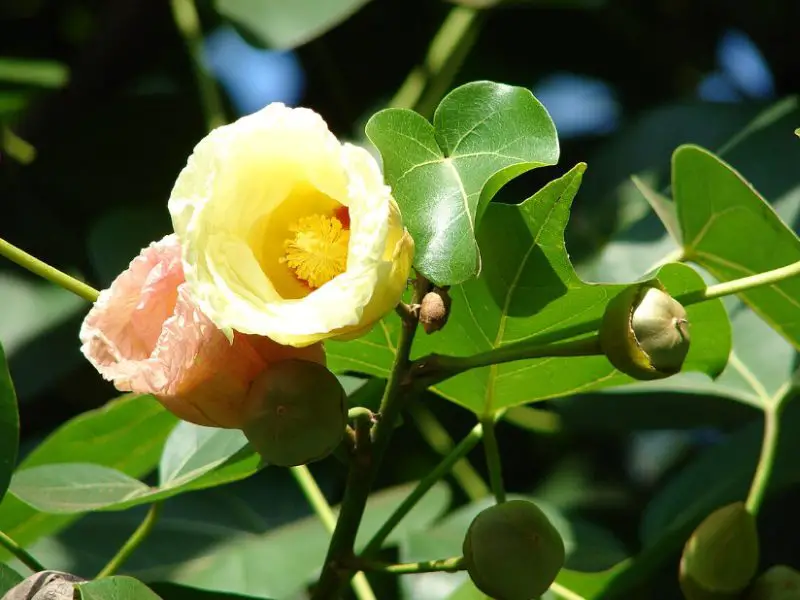
Thespesia populnea, commonly known as Milo, is a native evergreen tree or shrub in Hawaii, likely introduced by ancient Polynesians. Capable of reaching heights up to 40 feet, Milo features tulip-shaped flowers, up to 3 inches long, with yellow staminal columns and crinkled, overlapping petals aging from yellow to pink with red at the base.
Following the blooms, rounded seed capsules develop. The shiny, heart-shaped leaves are yellow-green to dark green. Thriving along the coast, Milo can endure brackish water conditions. Its bark is gray and lightly fissured, adding to the plant’s coastal charm in Hawaii.
Red Ginger
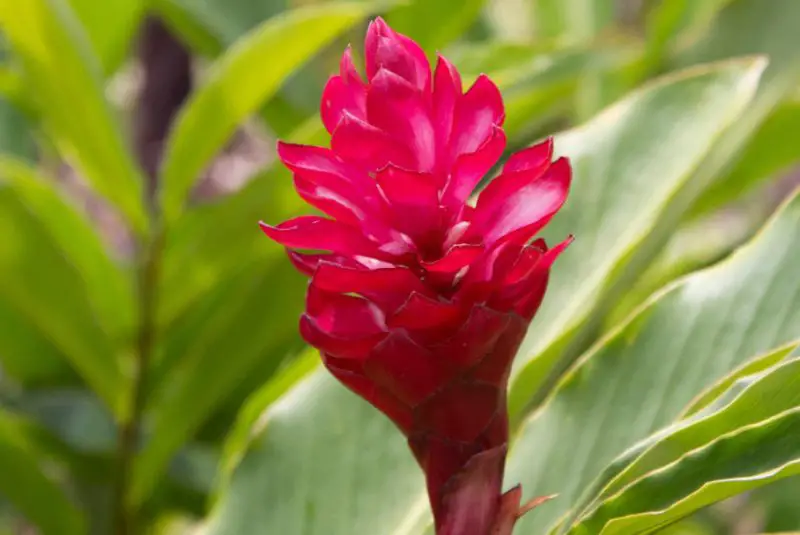
Alpinia purpurata, or red ginger, is an evergreen perennial herb/forb with colorful features. Originally from Melanesia, it has naturalized in Hawaii and added its exotic charm to gardens.
Nestled between eye-catching red, pink, or white floral bracts on terminal spikes, the plant bears stunning white tubular blooms. Even at 15 feet in altitude, it usually remains smaller. When young plantlets come into contact with the ground after emerging at the base of older inflorescences, they can take root.
Red ginger, a popular choice for tropical flower arrangements, grows well on the edges of lowland forests, trails, and roads in Hawaii. It has green oblong leaves and pseudostems that emerge from rhizomes.
Shell Ginger

Alpinia zerumbet, commonly known as Shell Ginger, is a perennial herb/forb renowned for its vibrant characteristics. Introduced to Hawaii from Asia, this ornamental garden plant has become a naturalized beauty.
Displaying multicolored flowers in shades of white, pink, red, and yellow, the plant can reach up to 10 feet in height. Its showy flower panicles, resembling cultured mussel ropes with pink and white shells, hang gracefully at the tips of pseudostems. The waxy, shell-like buds, tipped with pink, open into flowers with red mouths and red-veined, yellow lips. Following the blossoms, round vermilion seed capsules appear.
With solid green or variegated leaves, Shell Ginger is often cultivated for its aesthetic appeal. Occasionally escaping cultivation, it thrives in wet to mesic areas and finds use in tropical flower arrangements.
Pineapple
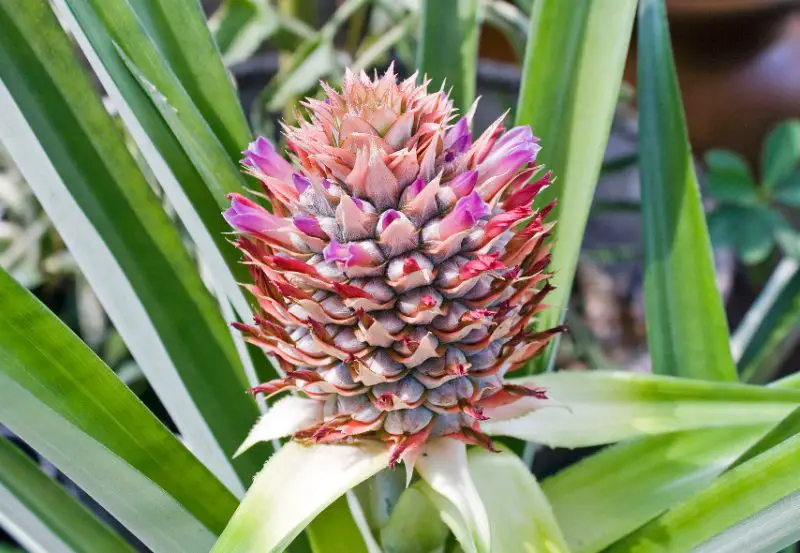
Ananas comosus, commonly known as Pineapple, is a perennial herb/forb with distinct features. Originally native to Brazil, it was introduced to Hawaii in the early 1800s and is now cultivated as a commercial food plant.
The pineapple-shaped inflorescences, in shades of reddish or brownish, boast numerous small violet flowers and small leaves. Pollination, typically done by hummingbirds absent in Hawaii, leads to seed production. Fruits are large, compound, and ripen in various hues, with each hexagonal section representing an individual fruit. Glaucous, sword-shaped leaves, often striped with pink, yellow, or white, complement the plant’s aesthetic appeal.
In Hawaii, Pineapples are commercially cultivated, reproducing asexually through suckers, offshoots, or planting leafy fruit tops. The Red Pineapple (Ananas bracteatus) is a related species with more colorful, spiny inflorescences and smaller fruit.
Anthurium
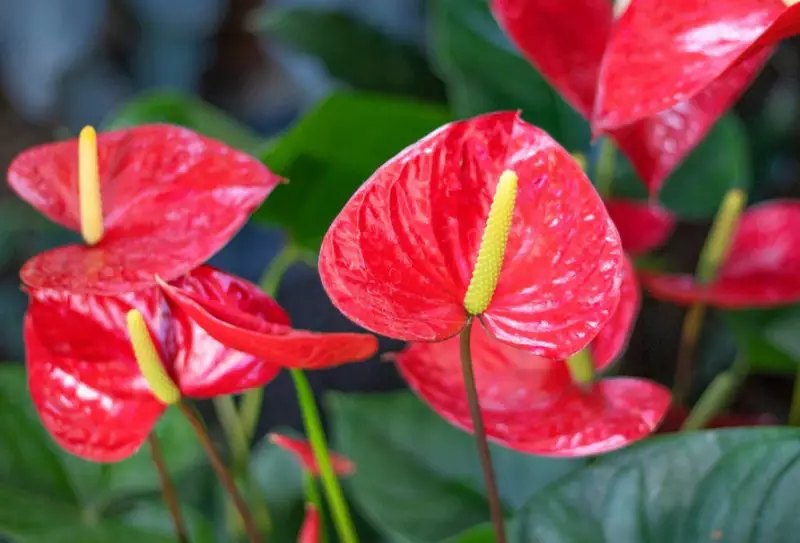
Anthurium andraeanum, commonly known as Anthurium, is a perennial herb/forb cherished for its ornamental allure. Originally from Colombia and Ecuador, it is now cultivated in Hawaii as an ornamental garden plant and houseplant.
The flowers, white or yellowish, are modest compared to the striking floral spathes in red, pink, green, white, cream, or multicolored. Blooming year-round, Anthurium can reach up to 3 feet in height. The unique inflorescence features tiny flowers on a finger-like spadix beneath a shiny, waxy, crinkled, heart-shaped spathe. Occasionally followed by small berries, the large, glossy leaves come in dark green or black varieties.
Thriving in shady, humid tropical gardens or commercially grown for export and cut flowers, Anthuriums are valued for their showy, long-lasting inflorescences in tropical flower arrangements.
People Who Read This Also Read:






